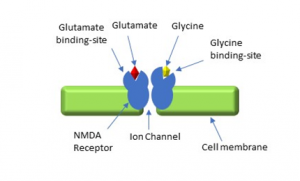CureGRIN Scientific Newsletter – Jan 2021
Share This Post

Welcome to the third edition of
CureGRIN Foundation’s scientific newsletter.
We are continuing to share updates on the latest publications about GRIN genes, NMDA receptors and other glutamate receptors every couple of months. We will also be discussing new developments in seizure treatments and other GRIN symptoms.
In this third edition, we summarize the findings of three recent peer-reviewed scientific research articles. First, we discuss an article published in Neuropharmacology and learn about positive allosteric modulators of NMDA receptors. Next, we discuss an article published in Brain describing a GRIN2A mouse model. We then discuss an article published in the Journal of Neuroscience on pain processing in Schwann cell GluN1-deficient (GluN1–) mice.
Could positive allosteric modulators (PAMs) serve as a treatment for patients with loss-of-function GRIN variants?
Researchers at Emory University, including Dr. Stephen Traynelis (a member of CureGRIN’s scientific advisory board), found that positive allosteric modulators could be considered to partially rescue NMDAR functioning and could potentially serve as therapeutics.
This study was aimed at utilizing functional data to test the effects of allosteric modulators on loss-of-function variants. Allosteric modulators are pharmacological substances that bind to the NMDAR and alter the response of the NMDAR to a particular stimulus. The positive allosteric modulators (PAMs) that were tested included 24 (S)-hydroxycholesterol, pregnenolone sulfate, and tobramycin. 24(S)-hydroxycholesterol is a metabolite catalyzed by the enzyme cytochrome P450 CYP46A1 in the central nervous system. The maximal response of NMDARs can be amplified by 24(S)-hydroxycholesterol. Pregnenolone sulfate is an excitatory neurosteroid that can affect the neuronal functioning of NMDARs function. Tobramycin is an antibiotic that acts as a selective PAM for GluN2B. These modulators are known to increase the charge mediated by the NMDAR when the receptor is being activated. In this study, the researchers studied 21 missense variants from different domains in GRIN1, GRIN2A, and GRIN2B that were found to result in a loss-of-function. The researchers also assessed the effects of a few co-agonists, including D-serine, L-serine, and D-cycloserine. They aimed to evaluate if these co-agonists could act as a substitute for glycine to result in improved NMDAR function. The results of this study indicate that the PAMs enhanced responses for these loss-of-function variants.
Yet, more research needs to be performed, such as testing the effects of these PAMs on transgenic animals with loss-of-function GRIN variants. However, these results suggest the possibility of pharmacological intervention which can help to rectify some of the effects of GRIN loss-of-function variants.
To learn more visit: Tang W, Liu D, Traynelis SF, Yuan H. Positive allosteric modulators that target NMDA receptors rectify loss-of-function GRIN variants associated with neurological and neuropsychiatric disorders. Neuropharmacology. 2020 Oct 15;177:108247. doi: 10.1016/j.neuropharm.2020.108247. Epub 2020 Jul 24. PMID: 32712275; PMCID: PMC7554152.
Creating GRIN2A mouse models of developmental and epileptic encephalopathy and assessing therapies
Researchers have identified drugs that boost survival in homozygous mice with a gain of function GRIN2A variant.
Patients with rare variants in GRIN2A typically present with a spectrum of symptoms. Some of these symptoms are epilepsy, hypotonia, intellectual disability, movement disorders, speech impairments, and visual disturbances. A de novo missense variant, c.1930A>G (p.Ser644Gly), was found in a patient presenting with developmental and early-onset epileptic encephalopathies (DEE). This patient presented with infantile spasms and developmental impairment as well. Researchers at Columbia University and collaborators from Boston Children’s Hospital, Harvard Medical School, Emory University, Central South University, and Children’s Hospital of Chongqing Medical University characterized this variant in Xenopus laevis oocytes, HEK293 cells, and in a Grin2a knock-in mouse model. The researchers examined seizure and behavioral phenotypes and tested the efficacy of NMDAR blockers. This study took a combined in vitro, in vivo, and ex vivo approach to better understanding the complex nature of GRIN2A-related disorder.
Testing of Grin2aS644G/+ mice revealed unusual seizures, abnormal hippocampal morphology, as well as complex neurological behaviors such as hyperactivity, decreased anxiety-like behavior, and repetitive behaviors. Additionally, the functional effects of this variant on channel activity revealed a gain-of-function effect. An off-label clinical treatment of memantine and dextromethorphan, both NMDAR antagonists, was given to the patient and resulted in a reduction of daily seizures. Therefore, the researchers wanted to assess the efficacy of NMDAR antagonists in the mouse model. Homozygous mice had tonic-clonic seizures which were lethal. Homozygous mice were treated with dextromethorphan, quinidine, as well as the combination drug Nuedexta® (made of dextromethorphan and quinidine), and radiprodil. These treatments extended survival from a median of 1 day up to a median of 5.5 days for Nuedexta® in the homozygous mice, suggesting that further research should be conducted on determining the effects of possible NMDAR antagonist therapies for gain-of-function variants.
To learn more visit: Amador A, Bostick CD, Olson H, Peters J, Camp CR, Krizay D, Chen W, Han W, Tang W, Kanber A, Kim S, Teoh J, Sah M, Petri S, Paek H, Kim A, Lutz CM, Yang M, Myers SJ, Bhattacharya S, Yuan H, Goldstein DB, Poduri A, Boland MJ, Traynelis SF, Frankel WN. Modelling and treating GRIN2A developmental and epileptic encephalopathy in mice. Brain. 2020 Jul 1;143(7):2039-2057. doi: 10.1093/brain/awaa147. PMID: 32577763; PMCID: PMC7363493.
How can the deletion of GRIN1 in the Schwann cells of mice affect the processing of pain?
Researchers at the University of California San Diego investigated the effects of conditionally deleting the GRIN1 gene in Schwann cells. Schwann cells work to myelinate axons throughout the peripheral nervous system. NMDARs are known to contribute to excitatory synaptic transmission, yet NMDARs have also been expressed in Schwann cells.
The researchers conditionally deleted GRIN1, which encodes the GluN1 subunit of the NMDAR, creating a Schwann cell GluN1-deficient (GluN1–) mouse model. This resulted in the myelination of sciatic nerves in the GluN1– mice being unchanged, but the density of some of the Remak bundle fibers (the Aδ and C-fibers) were increased and the Aβ fibers decreased. The Aβ fibers carry touch-related information, the Aδ fibers carry pain and temperature-related information, and C-fibers carry pain, temperature, and itch-related information. The mice were mechanically and thermally hypersensitive without injury.
Furthermore, the intraepidermal nerve fiber density (IENFD), a method of quantifying the unmyelinated C-fibers that cross the basement membrane zone of the skin, of the GluN1– mice was decreased, further suggesting the increased pain sensitivity and consistent with small fiber neuropathy. The researchers conclude that the NMDARs at Schwann cells play an important in the normal development of the peripheral nervous system and demonstrate a relationship between the physiology of Schwann cells and neuropathic pain. This mouse model may contribute to our understanding of small fiber neuropathy as well as fibromyalgia.
CureGRIN recently conducted an informal survey about GRIN-disorder pain tolerance, which had over 100 respondents. Many parental and caregiver respondents reported anecdotal observations of differences in perceived pain tolerance in patients with GRIN gene variants. Perhaps similar experimental design methods, as described in the aforementioned study, could be employed by researchers in the future to better characterize the pain sensitivity of GRIN-disorder patients.
To learn more visit: Brifault C, Romero H, Van-Enoo A, Pizzo D, Azmoon P, Kwon H, Nasamran C, Gonias SL, Campana WM. Deletion of the Gene Encoding the NMDA Receptor GluN1 Subunit in Schwann Cells Causes Ultrastructural Changes in Remak Bundles and Hypersensitivity in Pain Processing. J Neurosci. 2020 Nov 18;40(47):9121-9136. doi: 10.1523/JNEUROSCI.0663-20.2020. Epub 2020 Oct 13. PMID: 33051351; PMCID: PMC7672997.
About Us
This newsletter is assembled by CureGRIN Foundation. Our goal is to find cures and therapies for people around the world living with disease-causing GRIN gene variants. We know that for this to happen, clinicians, researchers, biotech companies and patient advocates need to collaborate. We want to accomplish these goals with your help! Contact me here.
In 2020, we held three GRIN Genes Research Roundtables. GRIN Genes Research Roundtables bring together leading GRIN, NMDARs, and other ionotropic receptor researchers to share research updates and exchange new ideas. If you are a GRIN/NMDAR researcher or clinician, please feel free to reach out to me at meagan@curegrin.org to be added to the next meeting invitation.
Meagan Collins, Research Coordinator
CureGRIN Foundation
5732 Regal Oak Lane
Parker, Colorado 80134
(303) 881-3425
Read more Posts

Understanding NMDA Receptors: A Guide for GRIN Disorder Families
Share This Post Share on facebook Share on linkedin Share on twitter Share on email By: Meagan Collins You’ve probably heard that GRIN genes contain

Count Me GRIN 2020
CureGRIN is looking for 100 GRIN Champions to help us raise $250,000 to fund research for a cure for GRIN Disorder.
